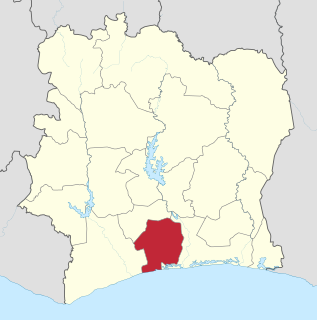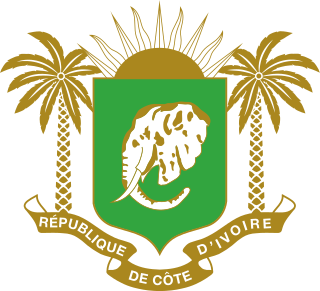
Agnéby Region is a defunct region of Ivory Coast. From 1997 to 2011, it was a first-level subdivision region. The region's capital was Agboville and its area was 9,234 km². Since 2011, the area formerly encompassed by the region is part of Lagunes District.

Bas-Sassandra Region is a defunct region of Ivory Coast. From 1997 to 2011, it was a first-level subdivision region. The region's capital was San-Pédro and its area was 26,440 km². Since 2011, the area formerly encompassed by the region is part of Bas-Sassandra District.

Fromager Region is a defunct region of Ivory Coast. From 2000 to 2011, it was a first-level subdivision region. The region's capital was Gagnoa and its area was 6,903 km². Since 2011, the area formerly encompassed by the region is the second-level Gôh Region in Gôh-Djiboua District.

Lacs Region is a defunct region of Ivory Coast. From 1997 to 2011, it was a first-level subdivision region. The region's capital was Yamoussoukro and its area was 8,875 km². Since 2011, the area formerly encompassed by the region is the Autonomous District of Yamoussoukro and part of Lacs District.

N'Zi-Comoé Region is a defunct region of Ivory Coast. From 1997 to 2011, it was a first-level subdivision region. The region's capital was Dimbokro and its area was 19,242 km². Since 2011, the area formerly encompassed by the region is part of Lacs District.

Savanes Region is a defunct region of Ivory Coast. From 1997 to 2011, it was a first-level subdivision region. The region's capital was Korhogo and its area was 40,210 km². Since 2011, the area formerly encompassed by the region is co-extensive with Savanes District.

Sud-Bandama Region is a defunct region of Ivory Coast. From 1997 to 2011, it was a first-level subdivision region. The region's capital was Divo and its area was 10,677 km². Since 2011, the area formerly encompassed by the region is divided between Bas-Sassandra and Gôh-Djiboua Districts.

Sakassou Department is a department of Gbêkê Region in Vallée du Bandama District, Ivory Coast. In 2014, its population was 94,525 and its seat is the settlement of Sakassou. The sub-prefectures of the department are Ayaou-Sran, Dibri-Assirikro, Sakassou, and Toumodi-Sakassou.

Botro Department is a department of Gbêkê Region in Vallée du Bandama District, Ivory Coast. In 2014, its population was 81,424 and its seat is the settlement of Botro. The sub-prefectures of the department are Botro, Diabo, Krofoinsou, and Languibonou.

Dabakala Department is a department of Hambol Region in Vallée du Bandama District, Ivory Coast. In 2014, its population was 189,254 and its seat is the settlement of Dabakala. The sub-prefectures of the department are Bassawa, Boniérédougou, Dabakala, Foumbolo, Niéméné, Satama-Sokoro, Satama-Sokoura, Sokala-Sobara, Tendéné-Bambarasso, and Yaossédougou.

Katiola Department is a department of Hambol Region in Vallée du Bandama District, Ivory Coast. In 2014, its population was 106,905 and its seat is the settlement of Katiola. The sub-prefectures of the department are Fronan, Katiola, and Timbé.

The districts of Ivory Coast are the first-level administrative subdivisions of the country. The districts were created in 2011 in an effort to further decentralise the state, but in practice most of them have not yet begun to function as governmental entities.

Gôh-Djiboua District is one of fourteen administrative districts of Ivory Coast. The district is located in the southwest corner of the country. The capital of the district is Gagnoa.

Gbêkê Region is one of the 31 regions of Ivory Coast. Since its establishment in 2011, it has been one of two regions in Vallée du Bandama District. The seat of the region is Bouaké and the region's population in the 2014 census was 1,010,849, making it the third-most populous region of Ivory Coast.

Niakaramandougou Department is a department of Hambol Region in Vallée du Bandama District, Ivory Coast. In 2014, its population was 133,818 and its seat is the settlement of Niakaramandougou. The sub-prefectures of the department are Arikokaha, Badikaha, Niakaramandougou, Niédiékaha, Tafiré, and Tortiya.

Centre Department was one of the original four departments of Ivory Coast. It was established in 1961, along with Nord Department, Sud-Est Department, and Sud-Ouest Department. During Centre Department's existence, departments were the first-level administrative subdivisions of Ivory Coast.
























